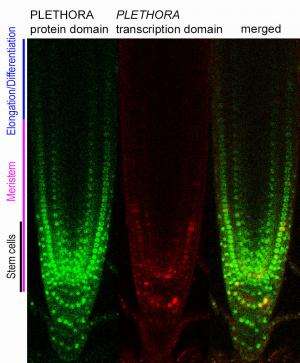Core mechanism for root growth identified

PLETHORA proteins and plant hormone auxin orchestrate root growth together.
During plant growth, dividing cells in meristems must coordinate transitions from division to expansion and differentiation. Three distinct developmental zones are generated: the meristem, where the cell division takes place, and elongation and differentiation zones. At the same time, plants can rapidly adjust their direction of growth to adapt to environmental conditions.
In Arabidopsis thaliana roots, many aspects of zonation are controlled by the plant hormone auxin and auxin-induced PLETHORA transcription factors. Both show a graded distribution with a maximum near the root tip. In addition, auxin is also pivotal for tropic responses of the roots.
Ari Pekka Mähönen from the University of Helsinki, Finland, with his group and Dutch colleagues has found out with the help of experimentation and mathematical modelling how the two factors together regulate root growth.
"Cell division in the meristem is maintained by PLETHORA transcription factors. These proteins are solely transcribed in the stem cells, in a narrow region within the meristematic cells located in the tip of the root. So PLETHORA proteins are most abundant in the stem cells," Ari Pekka Mähönen, Research Fellow financed by the Academy of Finland says.
Outside the stem cells the amount of PLETHORA protein in the cells halves each time the cells divide. In the end there is so little PLETHORA left in the cells that they cannot stay in the dividing mode. This is when the cells start to elongate and differentiate.
Auxin is the factor taking care of many aspects of root growth. If there is enough PLETHORA in the root cells, auxin affects the rate of root cell division. If there is little or no PLETHORA in the cells, auxin regulates cell differentiation and elongation. In addition to this direct, rapid regulation, auxin also regulates cell division, expansion and differentiation indirectly and slowly by promoting PLETHORA transcription. This dual action of auxin keeps the structure and growth of the root very stable.
When PLETHORA levels gradually diminish starting from the root tip upwards, the cell division, elongation and differentiation zones are created. And this inner organisation stays even if the growth direction of the root changes.
"The gravity and other environmental factors can change the auxin content of the cells, and quite rapidly. This all affects the growth direction of the root. And of course it is important for the plant to maintain the organization while directing their roots there where water and nutrients most likely are to be found."
More information: Ari Pekka Mähönen, Kirsten ten Tusscher,Riccardo Siligato, Ondřej Smetana, Sara Díaz-Triviño, Jarkko Salojärvi, Guy Wachsman, Kalika Prasad, Renze Heidstra & Ben Scheres. "PLETHORA gradient formation mechanism separates auxin responses." DOI: 10.1038/nature13663
Provided by University of Helsinki


















